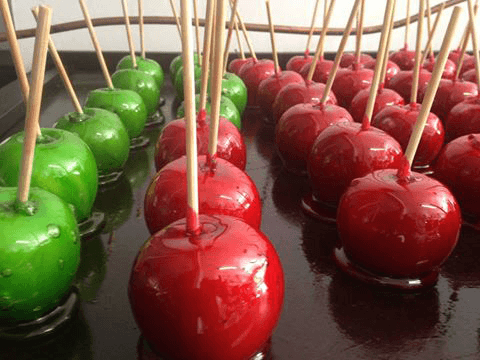
Candy apples
 |
|
| Alternative names | Toffee apple |
|---|---|
| Type | Confectionery |
| Place of origin | United States |
| Creator | William W. Kolb |
| Main ingredients | Apples, toffee or sugarcandy |
History[edit]
According to one source, American William W. Kolb invented the red candy apple.
Kolb, a veteran Newark candy-maker, produced his first batch of candied apples in 1908. While experimenting in his candy shop with red cinnamon candy for the Christmas trade, he dipped some apples into the mixture and put them in the windows for display. He sold the whole first batch for 5 cents each and later sold thousands yearly. Soon candied apples were being sold along the Jersey Shore, at the circus and in candy shops across the country, according to the Newark News in 1948.[2]
Ingredients and method[edit]
Candy apples are made by coating an apple with a layer of sugar that has been heated to hard crack stage (depending upon the type of sugar).[3][unreliable source?] The most common sugar coating is made from sugar (white or brown), corn syrup, water, cinnamon and red food coloring. Humid weather can prevent the sugar from hardening.[4]
Regional traditions[edit]
- Australia – the Granny Smith variety of apple is considered ideal for creating the children’s treat.[5]
- Brazil – candy apples (named as in other Lusophone countries maçã-do-amor, as in the French pommes d’amour, meaning “apples of love”) are common in the festivities in honour of John the Apostle.
- China – a similar treat called Tanghulu is made by coating small fruits, traditionally hawthorns with hard sugar syrup.
- Canada – very popular and usually eaten at fairs or carnivals.
- France – candy apples are called pommes d’amour (Apples of love). They are a common treat found at many festivals in France.
- Germany – most often associated with the Christmas season. They are also sometimes sold at carnivals and fairs
- Israel – almost solely sold in cities’ squares on Yom Ha’atzmaut eve (Israel Independence Day) as part of the street celebrations.
- Japan – candy apples, grapes, strawberries and tangerines are commonly available at Japanese festivals.[6]
- Republic of Ireland – eaten at Halloween.
- United Kingdom – associated with and eaten at Halloween (Scotland and Northern Ireland), Bonfire Night (England).
- United States – jelly apples, found in New York’s Coney Island area, are related but have a soft candy (“jelly”) coating and a cherry flavor, not cinnamon.[citation needed]
